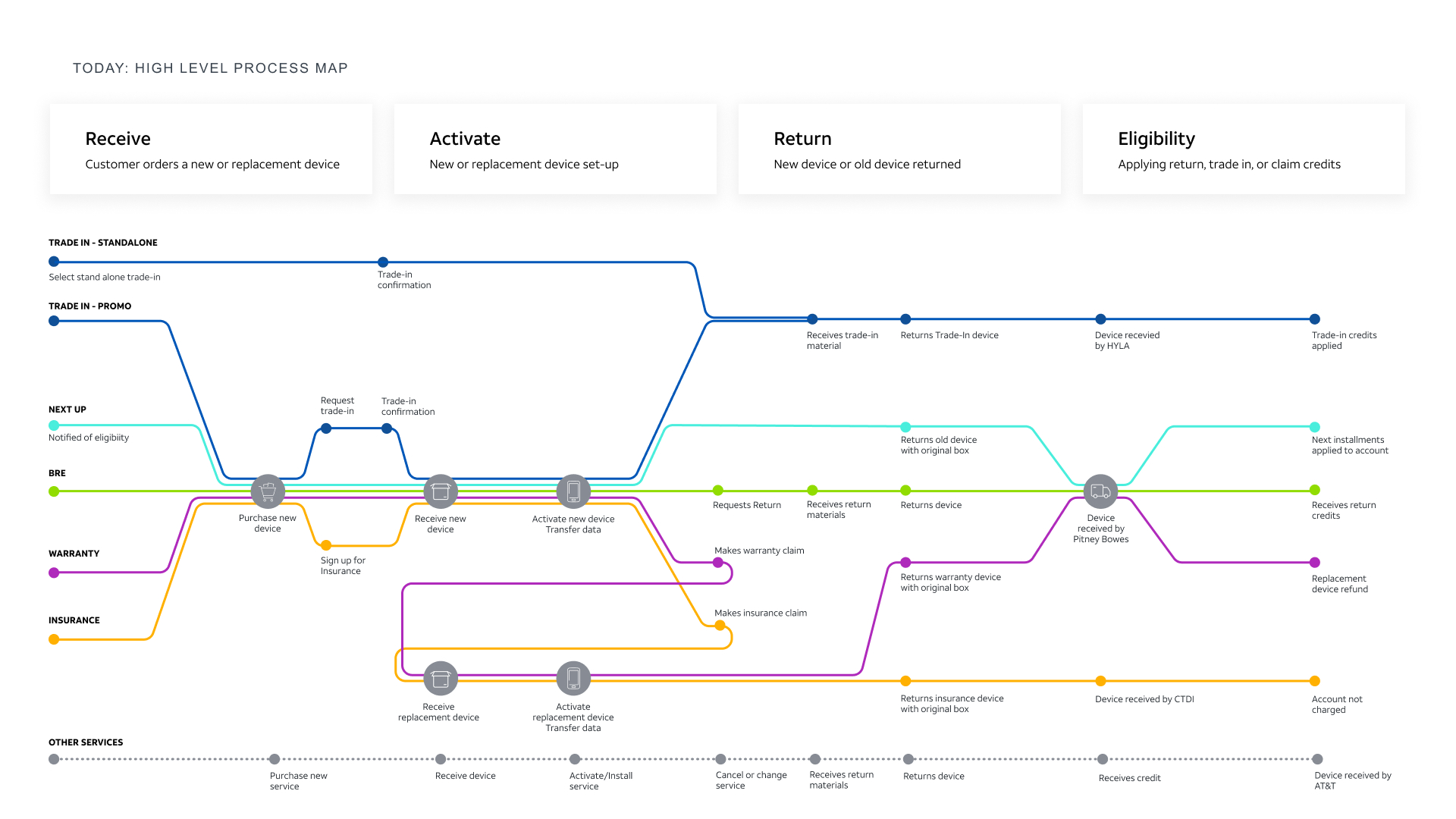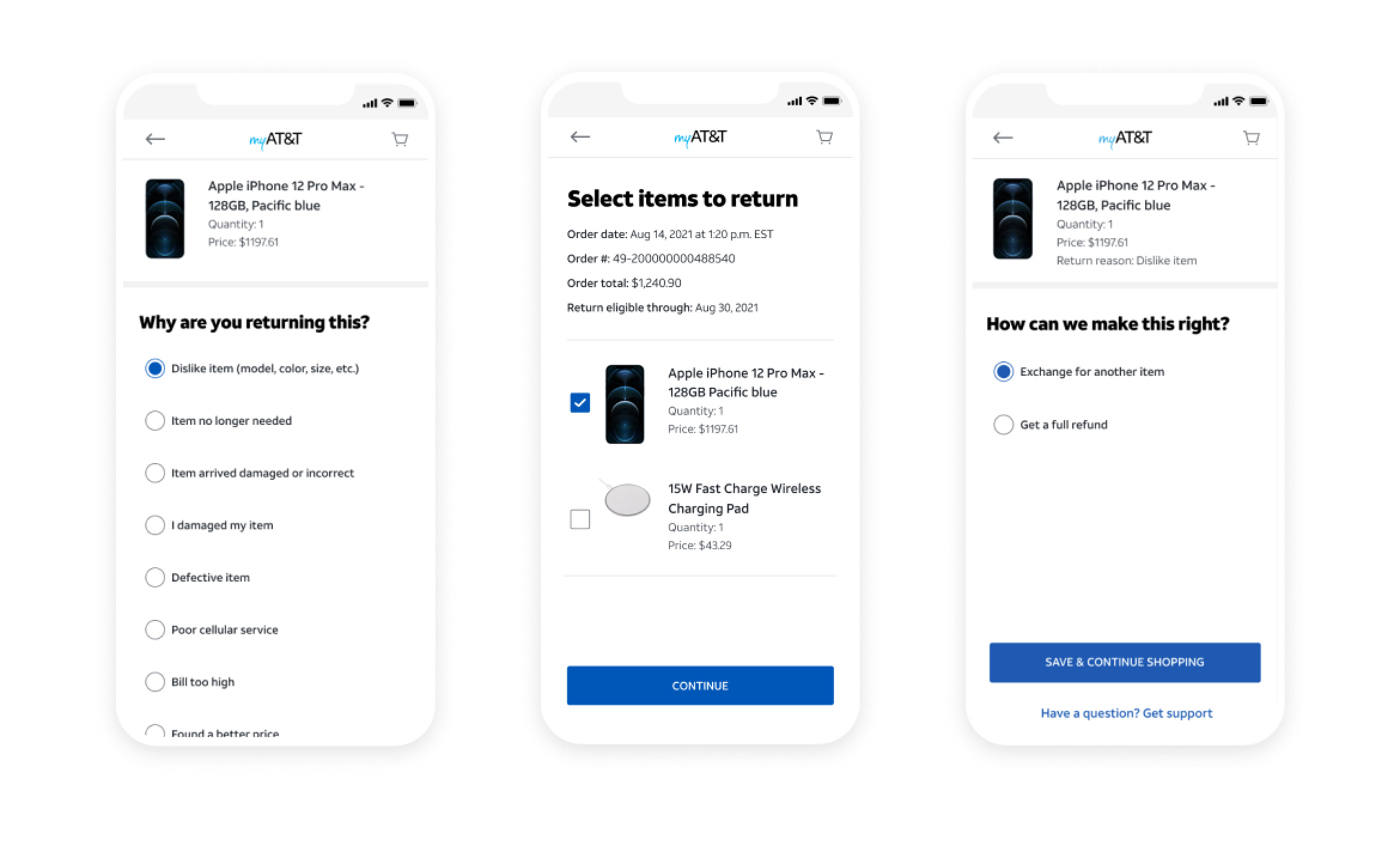Redesigning returns experiences at AT&T
The problem
Negative returns experiences hurt long-term relationships with customers, and they expect the experience to be easy. When AT&T began seeing high volumes of returns associated with trade in promotions is was clear our processes were flawed resulting in customer dissatisfaction.

Experience goals & principles
- Take decisions off the customer and do the work for them
- Consistency across return types
- Cohesive touchpoints across the return journey
- Flexible options that align with cohort preferences
- Guided experience for digital, communications and rep tools
- Minimize and eliminate complexity everywhere possible
KPI's
- Improve trade-in completion rate
- Increase NPS and CSAT across the return journey
- Call shed relating to device activation, return status and promotional credits
What we did
We started with quantitative data from our business partners and began to frame our work from there. We ended up creating a successful cross-functional operating model that is now being used as a framework for other projects at AT&T. #WinAsOne
Stakeholder interviews
Conversations with 18 stakeholders to understand where their teams fit, their ideal experience, and roadblocks they encounter.
Workshop participants
Our partners joined us for a design concept jam to identify needs and opportunites across 5 different return types.
Customer interviews
Conducted 1:1 qualitative interviews to identify issues and why they happen. Explored existing surveys to verify the findings.
User testing sessions
Validated the future state designs with our customers, focusing on a specific use case.

Today: complex processes
AT&T's supply chain and reverse logistics operations are complex. There are many 3rd party vendors involved across 5 primary return types and each of those business domains has unique challenges and needs. Over the years these business units operated independently of one another causing the complexity to build and reflect back on the customer experience.

Tomorrow: holistic approach
Approaching returns strategically for us meant stepping back and casting the vision of what an ideal state process would look like. This allowed us to drive towards a north star that we can use as a baseline for iteration.

Key moments
Before jumping into prototyping we mapped out the ideal state customer journey based on all of the research we had done. From there, we identified a few key moments that we felt were critical to a successful returns experience with a trade-in promotion. We map out key moments for each iteration of returns.

Outcome: trade in returns
Phones are expensive, and most people finance a device. If the process of trading in a device for a discount doesn't go smoothly it can impact a customers monthly bill in negative ways. We built a prototype based on experience principles we defined as part of our research. Our goal was to provide customers with an end-to-end and cohesive experience that felt easy, convenient and gave customers confidence everything was in good hands.

Outcome: buyers remorse returns
Trade-in returns were the first iteration we designed, which served as a baseline to build on for other return types. AT&T currently does not have a fully self-serve digital return flow. Buyers remorse returns are unintentional, as opposed to trade in. If a customer simply changes their mind about their purchase or they have a defective device, today, they need to call customer care or go into a retail store. We wanted to make this process simpler and straightforward. Our goal was also to make the exchange process easy so we can keep the customer relationship but get their issue resolved quickly and get them into a new device they love and that works for them.

The work continues
This project is still ongoing. We took a brief hiatus to focus on critical manufacturer changes to device activations. So far we have tackled 3 return types and plan to continue with insurance and warranty into 2022.
My Role
Associate Director, UX
As an associate director of user experience I lead multiple projects. I work directly with stakeholders to understand the problem space and work hands on with the design team to make the experience goals a reality. I often help shape the narrative of the work and present to cross functional groups, incorporating feedback as needed. While I work with a talented team of designers I roll up my sleeves and create designs as well when appropriate.
The returns work outlined below was nominated for an At Your Service award within AT&T. Full case study available for live presentation.